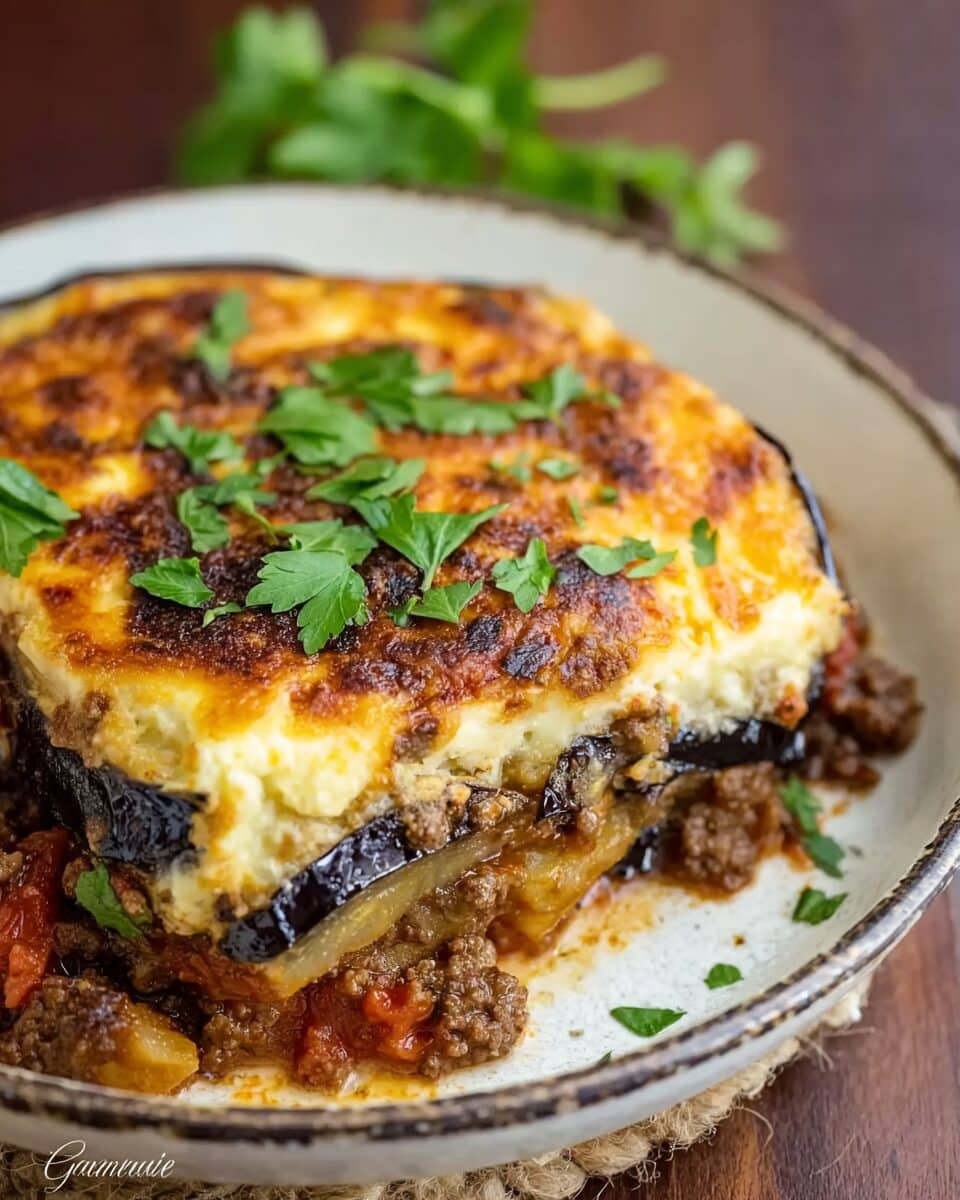The heart of Greek home cooking, moussaka is a beloved layered casserole dish that brings together the rich warmth of spiced meat sauce, the earthiness of eggplants and potatoes, and the creamy elegance of béchamel sauce. Every forkful delivers comfort, tradition, and bold Mediterranean flavor. Perfect for family dinners or weekend meal prep, this dish is not just a meal—it’s an experience. It’s the kind of recipe that fills your kitchen with the aroma of something truly special, and it tastes even better the next day. Whether you’re hosting or just craving something soul-soothing, Greek Moussaka is a classic worth mastering.
Full recipe:
Ingredients:
-
2 large eggplants, sliced into ½-inch rounds
-
3 medium potatoes, peeled and sliced into ¼-inch rounds
-
3 tablespoons olive oil
-
1 large onion, finely chopped
-
2 cloves garlic, minced
-
1 lb ground beef or lamb
-
1 can (14 oz) crushed tomatoes
-
2 tablespoons tomato paste
-
1 teaspoon ground cinnamon
-
½ teaspoon ground allspice
-
Salt and pepper to taste
-
¼ cup red wine (optional)
-
¼ cup chopped fresh parsley
For the Béchamel Sauce:
-
4 tablespoons butter
-
¼ cup all-purpose flour
-
3 cups warm milk
-
Pinch of nutmeg
-
Salt to taste
-
2 eggs, beaten
-
½ cup grated Parmesan cheese
Directions:
-
Preheat oven to 375°F (190°C).
-
Lightly salt the eggplant slices and let them sit for 20 minutes. Rinse and pat dry.
-
Lightly brush eggplant and potato slices with olive oil. Bake or pan-fry until golden brown. Set aside.
-
In a skillet, sauté onions in olive oil until soft. Add garlic and cook for 1 minute.
-
Add ground meat and cook until browned. Stir in crushed tomatoes, tomato paste, cinnamon, allspice, salt, pepper, wine, and parsley. Simmer for 20 minutes until thickened.
-
For the béchamel: Melt butter in a saucepan, add flour and whisk for 2 minutes. Gradually add warm milk, whisking continuously until smooth and thick. Remove from heat, stir in nutmeg and salt, then beat in eggs and half the Parmesan.
-
In a greased baking dish, layer potatoes, half the eggplant, all the meat sauce, remaining eggplant, and then pour béchamel sauce on top. Sprinkle with remaining Parmesan.
-
Bake for 45 minutes or until the top is golden and bubbly. Let rest 20–30 minutes before slicing.
Prep Time: 30 minutes | Cooking Time: 60 minutes | Total Time: 1 hour 30 minutes
Kcal: 465 kcal | Servings: 6 servings
A Taste of Greece: The Heartwarming Story Behind Moussaka
Moussaka is more than just a meal—it’s a comforting embrace from the Mediterranean. Deeply rooted in Greek culinary tradition, this dish is a favorite in homes across Greece and neighboring countries. Its layered structure of roasted eggplants, savory meat sauce, and creamy béchamel reflects a rich history of regional flavors and generations of family cooking.
Although moussaka is commonly associated with Greece, its roots span across the Middle East and the Balkans. The modern Greek version we know today was refined in the 1920s by Nikolaos Tselementes, a French-trained Greek chef who introduced the classic béchamel topping to the traditional dish. This added a luxurious French touch to an already hearty and rustic recipe, creating the creamy, golden-baked top we’ve come to love.
Why Greek Moussaka is a Timeless Favorite
There’s something irresistible about the combination of tender eggplant, soft potatoes, well-seasoned meat, and a smooth, cheesy béchamel sauce. Moussaka is the kind of dish that brings people together—whether it’s a weeknight family dinner or a weekend gathering with friends. Each slice is hearty, flavorful, and satisfying.
What sets moussaka apart is the contrast in textures. The vegetables become meltingly tender after roasting, the meat sauce is rich with tomato and spice, and the béchamel brings a smooth creaminess that ties it all together. When baked, the top becomes lightly golden, slightly crispy at the edges, and beautifully soft in the center—like a Greek version of lasagna, but with no pasta in sight.
The Power of Layers: What Makes This Recipe the Best
This particular recipe captures the essence of traditional moussaka while making it accessible for modern cooks. It uses baked rather than fried eggplant and potatoes, reducing the overall oil content while maintaining flavor and texture. It also includes classic Greek seasonings—cinnamon and allspice—giving the meat sauce an aromatic depth that is uniquely Mediterranean.
The béchamel sauce is thickened slowly, then enriched with eggs and Parmesan for that signature luxurious feel. By following this method, you ensure the top layer sets beautifully and doesn’t become too runny or overly dense.
And here’s the real secret: letting the moussaka rest before serving enhances the flavors. Like many layered dishes, moussaka tastes even better the next day, as the ingredients have time to meld into a unified, delicious whole.
Healthier Comfort Food That Doesn’t Sacrifice Flavor
You might not think of moussaka as a “healthy” dish at first glance, but when prepared mindfully, it delivers solid nutrition along with big flavor. Eggplants are rich in fiber and antioxidants. Potatoes provide complex carbs and essential vitamins like vitamin C and B6. The meat sauce adds protein and iron, and the béchamel, while creamy, can be made lighter by adjusting the butter or using low-fat milk if desired.
The beauty of this dish is its flexibility. You can substitute ground turkey for a leaner protein option or even swap in lentils for a vegetarian version. Use gluten-free flour in the béchamel and you’ll have a celiac-friendly meal that still tastes incredible.
It’s also a smart meal-prep choice. One pan gives you six hearty servings, and leftovers store and reheat well. Serve it with a simple Greek salad and you have a balanced, complete meal that feels both indulgent and nourishing.
Tips and Tricks for the Perfect Moussaka
-
Salt and rest the eggplant: This draws out excess moisture and bitterness. Don’t skip this step!
-
Roast instead of fry: Baking the vegetables keeps the dish lighter and less greasy while enhancing their natural sweetness.
-
Simmer the meat sauce thoroughly: Letting it reduce ensures the flavors concentrate and the sauce isn’t too watery.
-
Let it rest after baking: Moussaka slices best when it’s slightly cooled. Resting for 20–30 minutes makes all the difference.
-
Double the batch: This recipe freezes well. Make two, and enjoy one later for a no-stress dinner.
Serving Suggestions and Pairings
Greek moussaka is rich and satisfying, so it pairs wonderfully with light, crisp sides. Try it with a cucumber and tomato Greek salad dressed in olive oil and lemon, or some lemony roasted vegetables. A dollop of tzatziki on the side adds a refreshing tang.
If you’re entertaining, serve moussaka with warm pita bread, olives, and a glass of dry red wine like Agiorgitiko or a medium-bodied Merlot. For dessert, keep it traditional with baklava or Greek yogurt drizzled with honey and walnuts.
Why You’ll Keep Coming Back to This Dish
This recipe for Greek Moussaka is more than just a one-time dinner—it’s one of those dishes you’ll come to rely on when you need something hearty, impressive, and deeply satisfying. It’s perfect for family meals, meal prepping for the week, or impressing guests at a dinner party.
The reason people love moussaka goes beyond just flavor. It’s about comfort, tradition, and the feeling of being at home—whether you’re Greek or just love Greek food. This dish is a beautiful way to bring the flavors of the Mediterranean into your kitchen, one comforting bite at a time.
Conclusion
Greek Moussaka is a classic dish that has stood the test of time for good reason. With its comforting layers, fragrant meat sauce, and velvety béchamel, it offers a culinary experience that’s as nourishing as it is delicious. This recipe respects tradition while offering practical adaptations for the modern cook. Whether you’re making it for the first time or the tenth, moussaka never fails to deliver warmth, richness, and satisfaction. So next time you’re looking for a wholesome, flavor-packed dish that feels like a warm hug from Greece, give this moussaka a try—you just might find yourself adding it to your regular rotation.






